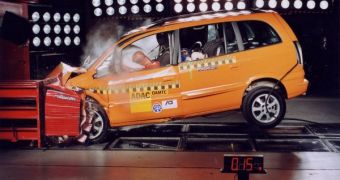Current crash-test performed on cars involve using crash test dummies fitted with up to 30 sensors than record impact forces in various points of the body and high-speed cameras. The dummies are full-scale replicas of human beings, weighted and articulated to simulate the behavior of a human body and instrumented to record as much data as possible on accident variables such as speed of impact, crushing force, bending, folding, or torque of the body and deceleration rates during a collision.
Although they are indispensable in the development of new safety measures, there is still room for improvement which came from a new study performed by researchers from The Ohio State University in Columbus.
Instead of using dummies, the scientists used two human corpses that were hit with a device that simulates a blunt impact equivalent to car collisions. It may sound cruel to some people, but the bodies were those of volunteers who had previously agreed to donate their corpses for medical purposes upon death.
But the real novelty, besides the fact that nothing can mimic the damage suffered by a human body on impact better than...a human body, is the cat that they used CT imaging of the rib cages of the cadavers to evaluate the damage caused by the impact.
Computed tomography (CT), also known as (CAT or CT scan) and body section roentgenography, is a medical imaging method employing tomography where digital geometry processing is used to generate a three-dimensional image of the internals of an object from a large series of two-dimensional X-ray images taken around a single axis of rotation.
The results were impressive. "We found that injuries to the rib cage caused by the simulated car collision could be identified on the CT scans and that the CT results correlated with the usual, more involved methods of body damage analysis, which makes use of high speed videos and data from sensors attached to more than 30 locations on the body during the impact," said Steffen Sammet, MD, PhD, lead author of the study.
"The study was initiated by a project from the Department of Transportation to enable objective, noninvasive measures of crash impacts. The knowledge gained from those tests goes directly into automotive engineering to prevent those disabling injuries or death," said Dr. Sammet.
Such applications of medical technologies can only benefit drivers and passengers alike, by giving the car manufacturers a clearer and more precise view of the traumas inflicted on a human body by a real collision, thus enabling them to develop new and better safety measures, that will hopefully decrease the current death toll of traffic accidents, of around 100 million people worldwide.

 14 DAY TRIAL //
14 DAY TRIAL //